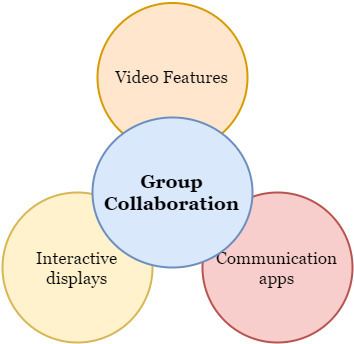 | ||
M-learning or mobile learning is defined as "learning across multiple contexts, through social and content interactions, using personal electronic devices." A form of distance education, m-learners use mobile device educational technology at their time convenience.
Contents
M-learning technologies include handheld computers, MP3 players, notebooks, mobile phones and tablets. M-learning focuses on the mobility of the learner, interacting with portable technologies. Using mobile tools for creating learning aids and materials becomes an important part of informal learning.
M-learning is convenient in that it is accessible from virtually anywhere. Sharing is almost instantaneous among everyone using the same content, which leads to the reception of instant feedback and tips. This highly active process has proven to increase exam scores from the fiftieth to the seventieth percentile, and cut the dropout rate in technical fields by 22 percent. M-learning also brings strong portability by replacing books and notes with small devices, filled with tailored learning contents.
Background
Mobile learning is the delivery of learning, education or learning support on mobile phones, PDAs or tablets. E-learning has provided the ability for traditional learning to break out of the classroom setting and for students to learn at home. Mobile learning has enhanced upon e-learning by taking it a step further and allowing students to learn virtually anywhere a mobile signal is available.
New mobile technology, such as hand-held based devices, is playing a large role in redefining how people receive information. The recent advances in mobile technology are changing the primary purpose of mobile devices from making or receiving calls to retrieving the latest information on any subject. "Numerous agencies including the Department of Defense (DoD), Department of Homeland Security (DHS), Intelligence community, and law enforcement are utilizing mobile technology for information management."
Classroom
Applications in classrooms and other learning spaces combine the use of handheld computers, PDAs, smartphones or handheld voting systems (such as clickers) with traditional resources. (Tremblay 2010).
Mobile devices in the classroom can be used to enhance student-centered learning, group collaboration among students through communication applications, interactive displays, and video features.
In a literature review conducted by FutureLab, researchers found that increased communication, collaboration, and understanding of concepts was a result of mobile technology applications.
Mobile devices can be used in brick-and-mortar or online settings to enhance learning experiences.
Podcasting consists of listening to audio recordings of lectures. It can be used to review live lectures (Clark & Westcott 2007) and to provide opportunities for students to rehearse oral presentations. Podcasts may also provide supplemental information to enhance traditional lectures (McGarr 2009) (Steven & Teasley 2009).
Psychological research suggests that university students who download podcast lectures achieve substantially higher exam results than those who attend the lecture in person (only in cases in which students take notes) (Callaway & Ewen 2009).
Podcasts may be delivered using syndication, although this method of delivery is not always easily adopted (Lee, Miller & Newnham 2009).
Work
M-learning in the context of work can embrace a variety of different forms of learning. It has been defined as the "processes of coming to know, and of being able to operate successfully in, and across, new and ever changing contexts, including learning for, at and through work, by means of mobile devices".
Learning for work, which could be also described as 'just-in-case' learning, involves classic and formal education activities, such as training courses, that prepare learners for future work-related tasks. A typical, corporate application is the delivery of mobile compliance training, which can be seen as a viable means to reach geographically mobile employees, such as consultants or staff in logistic and transport systems. Another application is mobile simulations that prepare learners for future situations, for example real-time SMS-based simulations for disaster response training.
Learning at and through work, which could be labelled as "just-in-time" mobile learning, occurs in informal education settings at the workplace. Employees can use the mobile phone to solve problems via handheld devices in situ, for example by accessing informational resources (such as checklists and reference guides) prior to customer visits or mobile decision support systems. The latter are popular in clinical settings where they support highly mobile medical staff through rule-based algorithms in the decision regarding more complex patient cases. Their application was associated with learning and in particular with practice improvement of medical staff. Learning through work also occurs by interacting with distant peers via phone. "People tagging" is an approach whereby people assign topics they associate with co-workers. The aggregation of interests and experiences serves not only as a means to raise awareness but also to help find competent experts on demand, for example with context-sensitive expert location systems.
Cross-contextual learning that bridges the gap between work settings and formal education formats has perhaps the biggest potential for work-based mobile learning, especially with respect to tertiary education systems. This involves approaches in which learning in the workplace is facilitated and substantiated (for example through formative assessments, reflective questions or the documentation of personal achievements in multimedia learning diaries or portfolios) The so-created materials are later used in more formal educational formats, for example in the classroom or in the discussion with tutors. The value of these mobile phone-mediated learning practices lies in the integration and reconciliation of work-based learning and formal education experiences which otherwise tend to remain separated.
Lifelong learning and self-learning
Mobile technologies and approaches, i.e. mobile-assisted language learning (MALL), are also used to assist in language learning. For instance handheld computers, cell phones, and podcasting (Horkoff Kayes2008) have been used to help people acquire and develop language skills.
Other
Value
Tutors who have used m-learning programs and techniques have made the following value statements in favor of m-learning.
Challenges
Growth
Mobile learning is widely used in schools, workplaces, museums, cities and rural areas around the world. In comparison to traditional classroom pedagogical approaches, mobile learning allows widened opportunies for timing, location, accessibility and context of learning.
Current areas of growth include:
